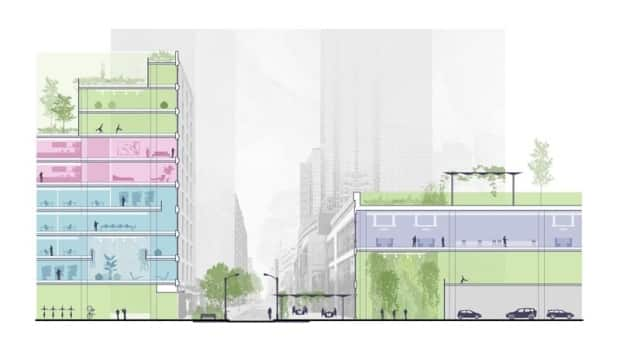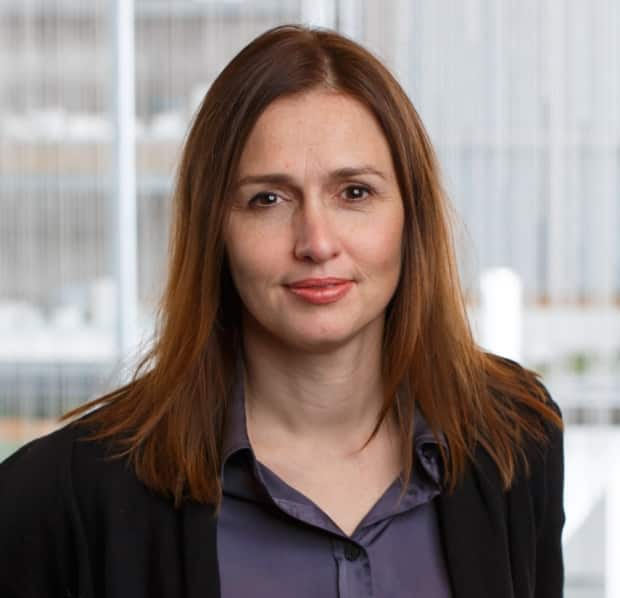How do you imagine Ottawa's downtown after COVID-19?

If you've made the trip to downtown Ottawa recently, you've likely noticed the desolate streets and empty storefronts. When we climb out of the pandemic, this city will have to grapple with its impact on the way we live, work and play, but it will also be a chance to think about how to make it better.
What could Ottawa look like post-COVID-19? What would it take to get you back to the city's core, once it's safe to gather again?
We asked experts in urban planning, design and architecture for their ideas.
PITCH 1: Green it and they will come
Architect Emmanuelle van Rutten

In architect Emmanuelle van Rutten's vision, office cubicles are replaced by multi-use gathering spaces, and there are more green features including living walls and rooftops.
In a post-COVID-19 city, many of us will continue working from home, reducing the need for office space, van Rutten said. The focus of the remaining office space will also change.

"The need for the office space is less about a stationary workspace, but more about a collaborative space and meeting space," explained van Rutten.
The pandemic has also put the spotlight on the importance of green space, especially in dense areas. For van Rutten, urban gardens can help foster that more collaborative working environment.
"Green spaces are places of encounter," she said.
She suggests upper floors of existing office buildings could be adapted for other uses including gyms and even residential space.
The challenge: There are potentially code and structural challenges when implementing green open spaces, as the weight of green roofs and the change in occupancy may be a hurdle.
The benefits: Open, green spaces promote better air quality, said van Rutten, and lend more opportunities to add windows, bringing natural light and potentially better ventilation into interior spaces.
PITCH 2: Same space, multiple uses
Urban planner Sheena Jardine-Olade

Asked how to improve Ottawa's core post-COVID-19, urban planner, mom and Kanata resident Sheena Jardine-Olade first thought about what it would take to get people like her downtown after work and parenting duties end for the day.
She believes that instead of treating the nighttime economy as an afterthought, people should find ways to use spaces around the clock, transforming the downtown from a mostly daytime destination to a 24-hour one.
Jardine-Olade proposes entrepreneurs find multiple ways to use a single space, depending on the time of day.

For example, a bookstore could turn into a gallery at night, a co-working space becomes a restaurant, or a café becomes a bar. We already see seasonal examples of this, like when city hall's outdoor plaza changes from a festival ground in the summer to an ice rink in the winter.
"We do see that a lot, this idea of having an area zoned for one thing and then possibly changing use based on how people use the area to another usage," Jardine-Olade said.
The challenges: Jardine-Olade predicts cost could be an issue as spaces would need to be redesigned so they can be easily transformed. She also said zoning would need to be more flexible in Ottawa, and there may be resistance from neighbours unhappy that the office building next to their condo is becoming a concert venue at night.
The benefits: "People feel safer when there's more vibrancy at night," said Jardine-Olade, adding that it could also help bolster businesses struggling post-pandemic.
"This might be an opportunity for them to share some of that burden with sharing money with rental spaces, increased traffic or just proximity."
PITCH 3: Low-cost parking near the core
Geographers Huhua Cao and Haotian Guan

As a supporter of sustainability, Huhua Cao said his idea isn't meant to encourage driving. He believes better transit is still the big-picture solution, but in the meantime people still need to be encouraged to make their way downtown.
But Cao, who owns a condo downtown and spends a lot of time in the core, has noticed there are few places to park nearby.
Although city hall does provide free parking on weekends and evenings, "it's not enough," he said, noting that in 2016 just under 11 per cent of the city's population lived downtown.
Cao would like to see improved transit and more parking spaces working in tandem, but he knows there will always be some for whom cars make more sense. Some suburban and rural residents don't have easy access to public transit. Even after the pandemic, some people may still feel reluctant to hop on the bus or train.

Cao suggests the private sector could be given incentives to offer parking for free or at a reduced rate. The University of Ottawa has parking lots that are not being put to full use on weekends and evenings, even though they're a short walk from the ByWard Market and Rideau Centre, he said.
Often, low-cost or even free parking spaces are out there but aren't well-known, added Guan.
"It is definitely one thing that should come into the government's mind to let people know that," he said, suggesting an app could help.
The challenges: It may be difficult to convince private parking lot owners to reduce what they charge, so incentives would be required. There's also the cost of developing an app.
The benefits: Creating parking near the downtown would also have the advantage of reducing traffic in the core, making it more attractive for pedestrians and cyclists.
Which is the best idea to overhaul Ottawa's core after COVID-19?
Vote for your top choice in our poll.
Or share your big idea with us.

